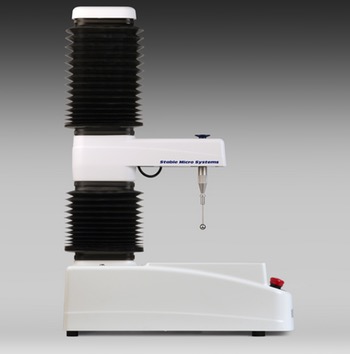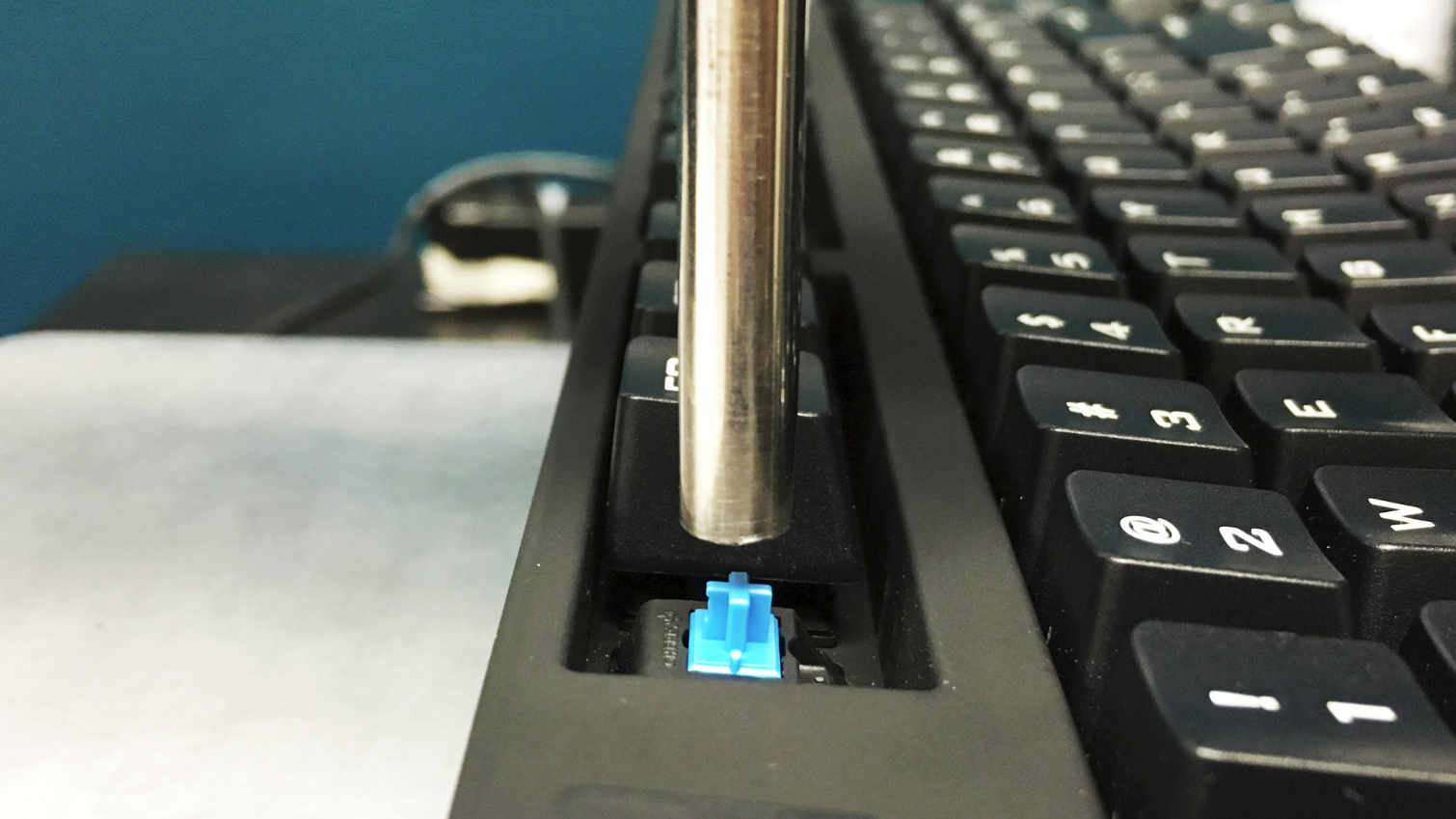Mechanical Keyboard Switch Testing Explained
We've employed a texture analyzer to test mechanical keyboard switches. Here's what it can measure, and what it can't.
How We Test
Historically, “testing” of switches has been woefully unscientific. In an effort to bring a more science-based and data-driven approach to evaluating switches, we run our keyboards (as well as samples of loose switches) through a machine called a texture analyzer. In our case, we specifically use the TA.XT Plus from Texture Technologies.
Texture analyzers are used in a variety of fields for a variety of purposes, but it’s ideal for testing keyboard switches. Simply put, we place a keyboard on the texture analyzer’s plate. We push a button to activate the test, which consists of a probe that descends, presses a key, and then retracts. Using its proprietary software, the texture analyzer records the data of the keypress and outputs it to a file. We gather that data and input it into our own template to generate our charts.
It records the force required to depress and release the key (all through the travel and rebound) and the distance the switch travels. These metrics together give us what’s called a force curve.
We perform the same test on every switch on every keyboard. For stabilized keys, we also run the test with the probe positioned directly above each point of stabilization. For example, the spacebar gets three runs: on the left side (above the stabilizer), in the middle (above the switch), and on the right (above the other stabilizer).
To ensure accuracy, we’re careful to position the keyboard in such a way that it cannot wobble, which could throw off the measurements to a certain degree. We also manually and forcefully press each key multiple times before running any tests to ensure that all key caps are firmly seated - sometimes key caps on shipped keyboards are slightly loose, and loose key caps return test results that appears as outliers.
Setting the test parameters is important, for safety and practical reasons. The probe is quite strong; for example, if you get your hand caught underneath it while it’s descending, you’ll end up with gelatin for an appendage. Therefore, in order to avoid sending the probe cracking through a keyboard, we set the test parameters carefully. We capped the force such that we knew for sure that the travel would complete, but not so much that we were jeopardizing the integrity of the keyboard.
You can also set the speed of the probe. It can depress and the release the key over the course of many seconds, or perform a rapid press, as if you just tapped the key with your finger. However, the faster the press, they less data the machine acquires about the keyfeel. A fast probe will show a smooth line; a slower probe will be more jagged, and that tells us something about how smooth the shaft actually is. There is an “nth degree” to this, though; if you set the probe to go too slowly, the force curve becomes so jagged as to be almost unreadable.
Get Tom's Hardware's best news and in-depth reviews, straight to your inbox.
Therefore, we settled on a test speed that captures enough of the key feel for us to draw some conclusions. The press is two seconds (the release is a little faster). Each test run produces the force curve of one switch and collects around 100 data points per millimeter of travel, total. Because there are over 100 individual keys on a full-size keyboard, then, testing a keyboard with switches that have 4mm of travel generates approximately 40,000 data points.
Understanding Switch Terms
The terms used to describe switches include:
- Pretravel - The distance from the beginning of a keypress to the actuation point.
- Actuation point - The point at which the switch triggers a keypress event. The pretravel ends at the actuation point.
- Actuation force - The amount of force required to push the switch down to the actuation point.
- Tactile point (depending on the switch type) - The point in the key travel where the tactile bump is located.
- Tactile force (depending on the switch type) - The peak force required to push the switch past the physical “bump” in the key travel.
- Full travel - The distance from the beginning of a key press to the bottom of the key travel.
- Bottom-out force - The amount of pressure required to push the switch to the bottom of the key travel.
- Reset point - The point at which the switch stops registering a keypress. The switch must cross this point after a keypress before the switch can be actuated again.
- Key feel - A description of the relative sensations when operating a switch. For example, if it feels smooth or scratchy, light or heavy, or if the tactile bump is sharp or gradual, strong or weak, etc.
- Hysteresis - The delta between the actuation point and reset point.
MORE: Best Deals
MORE: How We Test Mechanical Keyboards
MORE: All Keyboard Content
Seth Colaner previously served as News Director at Tom's Hardware. He covered technology news, focusing on keyboards, virtual reality, and wearables.
-
hunshiki I would be glad to read durability tests.Reply
As in for example a Brown switch is how hard to press at first, and how it degrades.
Because I used Blue and Brown switches, and they both get mushy after a few years of use. Brown was like 1 year, Blue was ~2-3 before getting mushy. They both just lose that tactile bump feel to them.
The Brown cap kb was a Corsair Strife RGB, the Blue was a Razer BlackWidow. Cherry cap, original, older model.
Of course this test could only work with tactile ones as Reds don't change with time. For example Reds simply bottom out and that's the only feel you can get out of them. -
raulinbonn I'm looking forward to measurements and comparisons between mechanical Cherry Blue switches vs. the recent hybrid from Razer, the so called "mechamembrane" Ornata, which I find to be excellent and pretty much peerless for typing purposesReply -
scolaner Reply19596566 said:I would be glad to read durability tests.
As in for example a Brown switch is how hard to press at first, and how it degrades.
Because I used Blue and Brown switches, and they both get mushy after a few years of use. Brown was like 1 year, Blue was ~2-3 before getting mushy. They both just lose that tactile bump feel to them.
The Brown cap kb was a Corsair Strife RGB, the Blue was a Razer BlackWidow. Cherry cap, original, older model.
Of course this test could only work with tactile ones as Reds don't change with time. For example Reds simply bottom out and that's the only feel you can get out of them.
Well yes, so would we. :) As we stated, we just don't have the capability to test that at this time. If you have suggestions for tools we could use to do so (that aren't super-expensive pieces of factory equipment), please let us know! -
cats_Paw I am quite sure anyone who ever used a mechanical keyboard can confirm that the 50 million clicks is a myth.Reply
I have used 3 keyboards in 5 years (two of them are dead now) and I certainly did not click 50 million times on the same key.
But ofc, who is gonna bother to confirm this?
Id say 1-3 Million is a bit more realistic. -
munted Is a standard office membrane keyboard going to be tested for comparison? I've used Cherry Blue and Brown switches and found both of them quite tiring to type on although I didn't use them for very long, I've always wondered how much effort a mechanical keyboard is compared to a membrane.Reply -
bettsar I'd love to see an article that compares 1 or 2 cheap rubber dome keyboards to some with mechanical switches. Texture, noise, force. It would be interesting, and potentially helpful in understanding whether I should spring for a nice mechanical keyboard or not.Reply -
scolaner Reply19605903 said:I'd love to see an article that compares 1 or 2 cheap rubber dome keyboards to some with mechanical switches. Texture, noise, force. It would be interesting, and potentially helpful in understanding whether I should spring for a nice mechanical keyboard or not.
We do have data on that. We have a ton of content coming based on all our testing, but that's one I hope to tackle when I have the chance. -
scolaner Reply19611937 said:Roughly how long will it be before we start seeing articles using this type of data?
POOF, your wish is granted :D : http://www.tomshardware.com/reviews/patriot-viper-v760-mechanical-gaming-keyboard,4798.html


